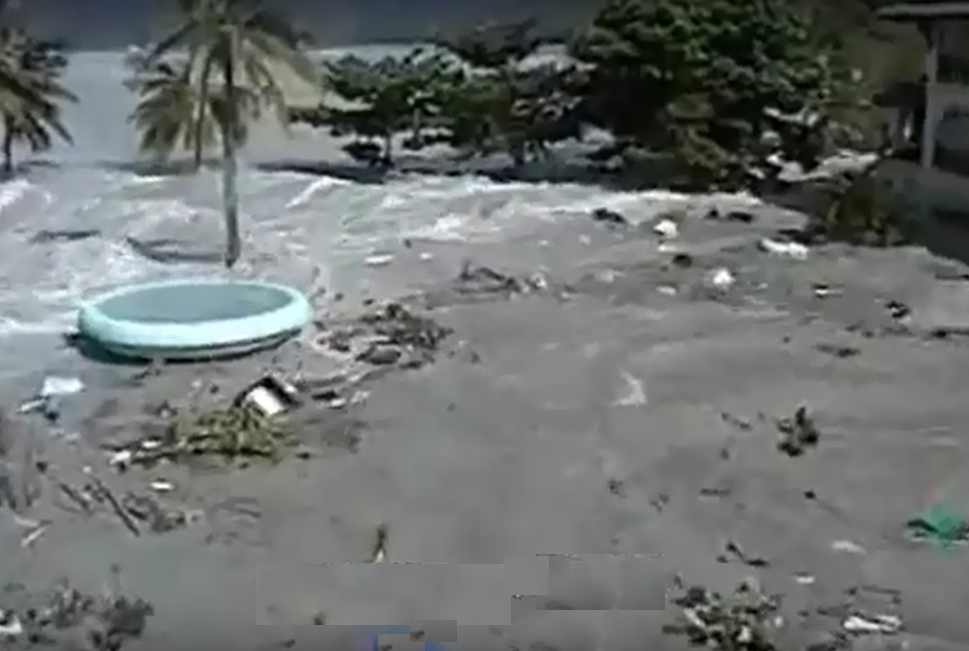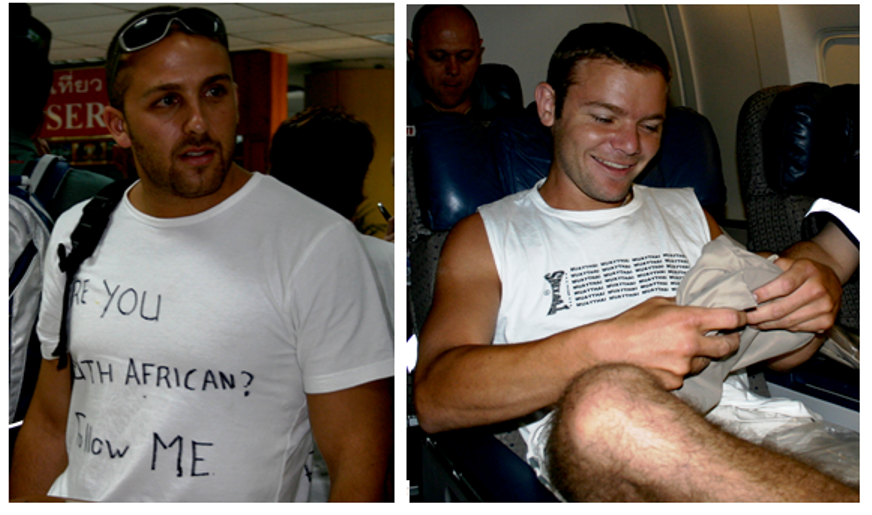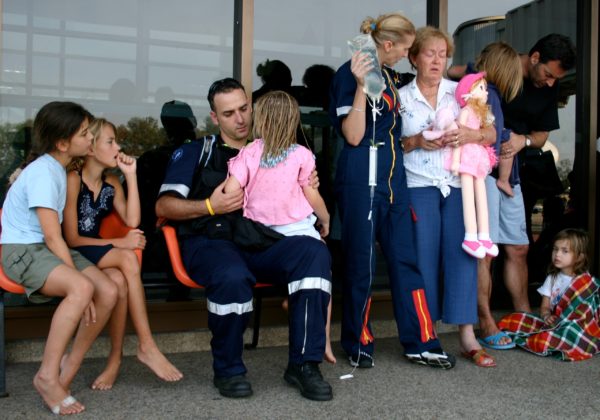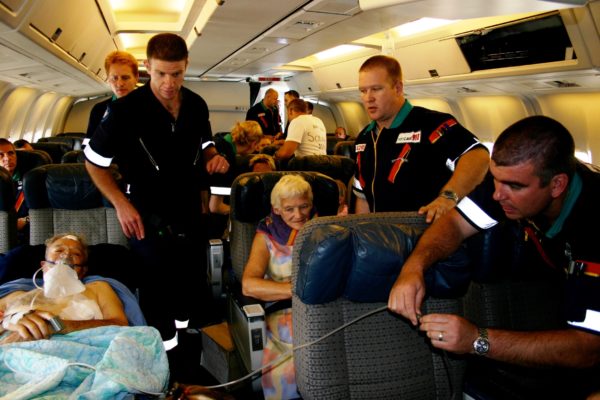David Saks is Associate Director of the South African Jewish Board of Deputies and Editor of Jewish Affairs. The following is an edited version of his article which first appeared in the Pesach 2005 issue of this journal.
When the ocean waters abruptly receded on the morning of 26 December 2004, it was a last-second warning to those lining the beaches throughout the eastern Indian Ocean that a massive catastrophe was about to unfold. A lucky few realized that something was wrong and began fleeing inland. Some would have been aware that a sudden withdrawal of the sea was a sure sign of an approaching tsunami, while others may simply have guessed that this extraordinary reversal of nature’s course could bode little good. At any rate, in the absence of any warning system, the recession of the waters was just about the only indication of what was to come. For over 300 000 unsuspecting people, from Indonesia to Thailand, Sri Lanka and India and all the way across the Somaliland on the west coast of Africa, it represented a silent death knell.
Tsunami – the word means “harbour wave” in Japanese, although so benign, almost banal, a rendition belies the destructive force of a phenomenon whereby vast walls of displaced water are propelled at terrifying speeds across the ocean. The Indian Ocean tsunami began with a massive undersea earthquake, the fourth largest ever recorded, off the western coast of northern Sumatra, Indonesia. The quake in turn generated a correspondingly massive tsunami. Ships are hardly affected by such upheavals, but once the waves reach land, the consequences can be devastating. Such was the case on that fateful Boxing Day of 2004.
What made this tsunami an international event was the fact that it occurred at the height of the holiday season, resulting in holidaymakers from all over the world being caught up in the tragedy. Amongst them were over 2000 South Africans vacationing in Thailand, particularly those on islands like Phuket and Phi Phi along its South Western coast. Approximately 200 of these were Jewish community members.
At 09h30 on 26 December, Mandelle Bernstein was in her Phuket hotel room. Three times during the night she had been aware of some tremors, but thought little of it at the time. Her husband Stephen and children David and Lisa were in the dining room about to have breakfast. A second daughter, Jody, was out with a friend. All of a sudden, she recalled, “people started to scream and point to the ocean. People started to run, just dropping their plates and screaming. It was just brown muddy water coming at one hell of a speed”.
Amidst scenes of panic and hysteria, the Bernsteins fought their way up to the fourth level of the hotel as the surging waves engulfed the streets outside and poured into the building. Wading through the incoming flood, they reached the stairs only just in time.
Meanwhile, similar scenes were taking place along coastlines throughout southern Thailand. Capetonians David Gordon, Rael Levitt and the Murinik family, Pam, Ralph and their son Dean, were breakfasting on the terrace of the Patong Beach Holiday Inn, while their friends Morris Isaacson and his long-time companion Dolores Ribeiro were out for a walk. It was Gordon who first saw the rapidly approaching wall of water and shouted a warning. He and Levitt were able to make their way to safety in the nearby hills, but the Muriniks were swept up by the water and together with fellow residents and floating debris of every description carried from room to room. They eventually ended up in the hotel conference room, by then to their necks in water; thankfully, the flood then began subsiding.
On Phi Phi island’s Charlie Beach Resort, Johannesburger Paul Sender and his companion from Pretoria Gabi Baron heard rather than saw the approaching deluge. Gabi remembered “a deafening hissing-rumbling noise like a jet engine at full throttle about to explode”, and which in that first moment of panic was assumed to signify a terrorist attack. Paul dragged her into the bathroom, moments before the bungalow was struck and within seconds demolished by a giant wave. Paul was probably killed outright by the collapsing walls. Gabi, badly injured but alive, was dug out two hours later. After lying on a beach for eight hours covered by a blanket, she was airlifted to the hospital in mainland Krabi.

Tsunami waves engulf grounds of a hotel, Phi Phi Island
Other South Africans also narrowly escaped death in the surging waves. Joanne Brown was swept up against a bungalow and her eighteen month-old daughter was wrenched from her arms. Miraculously, the infant somehow ended up in the arms of her nanny, Vicky Nwayo, who was nearly pulled into the sea but managed to wade to shore. Friends Lauren Isaacs, Jodi Kramer and Sandra Loeb were walking towards the beach in Phi Phi when the wave struck and swept them back towards their hotel. All three narrowly survived, in Isaacs’ and Loeb’s case by respectively hanging on to a pillar and a floating table and in Kramer’s because a man was able to pluck her to safety from his balcony.
Those who survived to recount their experiences afterwards were among the lucky ones. For Morris Isaacson and Dolores Ribeiro, trapped in an underground supermarket, there had been no escape. Their friends eventually found them lying side by side among hundreds of piled-up bodies. Nor had there been any escape for Paul Sender, and for fellow South Africans Nicola Liebowitz, Avadya Berman, Roy Fitzsimmons, Daphne Coetzee, Anna Fitzgerald, Anita and Anthony de Gouveia, Lisa Sun Lung, Stefan le Roux, Magda Findlay and Bevan and Louis Panaino. Their lives and those of many thousands of others had been extinguished within minutes.
Yehuda Kay, National Director of the South African Jewish Board of Deputies, was on a Muizenberg beach when he received a call from Russell Kaye, National Director of the Community Security Organisation informing him that several South African Jews in Thailand had been caught up in an earthquake and might need assistance. Kay contacted the Department of Foreign Affairs, but learned nothing further. At this stage, the government too knew little about the unfolding tragedy.
Soon afterwards, Kay received a second call from the CSO – more names were coming through, with every indication being that this was only the beginning. By 18h00, a list of fifteen people affected by the disaster had been compiled. At 20h30, it was decided to activate the CSO’s Incident Management System (IMS) to assist with incoming enquiries and gather information on those missing or injured. The IMS was designed in response to the terrorist attacks of 11 September 2001 and the double shul bombing in Istanbul, Turkey, in 2003. The system lays out how the CSO should deal with a disaster within the Jewish community, and how the various community structures would come together to manage any crisis that might arise. Although the IMS makes provision for possible natural disasters, it was never expected that it would be applied to assisting South Africans abroad. Kaye began putting a task team together, and by 21h00 that evening the call centre was operational.
Already, from its deceptively quiet beginnings, the initiative had mushroomed into a major nation-wide operation that would gather ever-increasing momentum in the frenetic days that followed. By mid-afternoon on Sunday, Kay was receiving a virtually unbroken string of calls from Jewish community members seeking information on relatives in Thailand. The initial list of missing persons he had jotted down was sent on to Mandi Romain, his chief liaison in Johannesburg, with the instruction that it be conveyed, together with any other information obtained, to the CSO. He also alerted the SAJBD management committee, comprising National Chairman Michael Bagraim, National President Russell Gaddin, national vice-chairmen Lester Hoffman and Ivan Levy and Gauteng Council chairman Zev Krengel. Krengel was to be in the engine room of the Jewish relief effort at every stage of the process and acted as the Board’s spokesperson once the Board’s Communications Department, headed by Charisse Zeifert, swung into action.
It was clear by mid-day on 26 December that a general call to the community was needed, but the late December period was the worst possible time for this. An alert was posted on the SAJBD website and group e-mails sent out, but few were at their computers to read them and in addition most Board and CSO staff members and volunteers were on holiday. To make matters worse, the crisis had broken on a Sunday. The only recourse was to use cell phone technology, and in due course hundreds of SMS’s were being sent out to every conceivable recipient, asking anyone who had information on Jews in Phuket to get in touch with the call centre. Recipients in turn SMS’d their groups, resulting in a ripple effect throughout the Jewish community. After the number had been given out over the radio, non-Jews too began utilising the service when they were unable to get through to the Department of Foreign Affairs.
The call centre, manned at all hours by volunteers on a rotational basis, provided an information resource and emotional support for community members affected by the tragedy. The IMS had prepared standard forms for all those calling in with information on missing individuals – who they were, whether they were missing or if they had since been found and their last known whereabouts. The details of the caller were also recorded so that they could be contacted at a later date if anything needed clarifying or if there was anything new to report. Netcare and the Department of Foreign Affairs were also operating call centres, while Discovery Health’s insurance records likewise provided important data.
They key to the success of the operation was information exchange between all those involved. Mandi Romain, based at Netcare’s Midrand headquarters, acted as the liaison between the Board, Foreign Affairs, Discovery Health and Netcare as information and enquiries flooded in over the next few days. She worked closely with Mande Taubkin, chief officer of Netcare’s disaster management team. Sheer adrenaline only would get her and her colleagues through the week that followed, a time when sleep was snatched in minutes rather than hours. The general community assisted in many ways. Nussbaums kosher butchery and the kosher pizzeria Michelos provided meals free, or at a discount, for those manning the call centre and scores volunteered to assist in the centre at all hours.
Without the efforts of volunteers on the ground in Phuket, much less would have been achieved. CSO member Daniel Treisman and his companion Taryn were on Phi Phi Island when the giant waves struck. Originally, they had been occupying a bungalow right on the beach, but had moved because of a double booking. The manager’s error undoubtedly saved their lives. Their new bungalow stood on stilts and about 100 meters behind it was a hill. As a result, it was the only structure still standing after the waters had swept in and then receded with even more devastating effect, dragging the other bungalows with them like so many pieces of driftwood.
The couple, together with scores of others suddenly made homeless, spent a night on the nearby hill and then made their way to Krabi on the mainland. There, in the hospital, Treisman met Gabi Baron, who told him that Paul Sender was dead. He was then contacted by Rabbi Nehemya Wilhelm, head of Chabad House in Bangkok, who urged him to do all he could to find Sender’s body. He thus embarked on what would be a non-stop three-day mission that developed into a mission to assist all fellow South Africans.
In a chaotic atmosphere of grief, chaos, confusion and fear, years of dedicated CSO training kicked in. Treisman, now in constant contact with CSO and SAJBD personnel back home, set about finding as many South Africans as possible and directing them to gathering points, assisting where he could with the injured and traumatised. All new information was relayed back to the call centre in Johannesburg. Newspapers all over South Africa later showed a young man whose white T-shirt bore the legend “Are you South African? Follow me”. Treisman had penned these words himself to enable other South Africans needing assistance to come to him. Featured in newspaper reports countrywide, the slogan came to epitomize the Jewish community’s effort on behalf of their fellow citizens.
Over the next few days, Treisman visited every hospital and morgue in Krabi. The search was an exceedingly grim one, entailing viewing many hundreds of bloated corpses already fast decomposing in the tropical heat. Unbeknown to him at the time, fellow CSO member Gavin Pearl was doing the same thing on Phuket. The two later met up at Phuket airport and thereafter worked together.

Tsunami heroes Daniel Treisman and Craig Pearl
Wrote tsunami survivor Mandelle Bernstein: “My praise and gratitude goes out to these young boys who amidst dealing with their own traumas got down to doing one of the hardest jobs ever and that was to locate dead and injured South Africans. They spent the entire two days running from hospital to hospital and from mortuary to mortuary trying to locate any South African. Above all, they were answering all our SMSs immediately and keeping us well informed as to what was happening”.
Other South Africans, most of them Jewish, also distinguished themselves. Ivor and Bernice Karan were at the time cruising around the world and had providentially stopped over for a few weeks in Phuket. Having at hand all the requisite facilities on their yacht, including e-mail, a colour printer and satellite phone, they were able to play a pivotal role in searching for missing South Africans, posting colour photocopies of those still unaccounted for and relaying the information back to the call centre. Bernice further hired a taxi and interpreter and went around all the hospitals looking for South Africans. The Karans were assisted by Jonty and Tanya Waksman, who spent many exhausting hours searching for missing countrymen, specifically Paul Sender and Avadya Berman, and made many harrowing visits to the morgues. The couple ended up making and receiving over six hundred phone calls. The most moving contribution, however, was surely made by Deanne Fitzsimmons, whose husband, Roy, had been amongst those engulfed in the killer waves but who nevertheless put aside her grief to do all she could to render assistance.
The tsunami disaster attracted worldwide Jewish assistance, even though only a few dozen Jews at most were amongst the estimated 300 000 victims. Israeli rescue teams like Zaka, an emergency-aid group formed by ultra-Orthodox Israelis whose tasks include ensuring proper Jewish burial for the victims of suicide bombings, rendered invaluable assistance to anyone who needed it, whether they were Jewish or not. This was true, too, of Rabbi Wilhelm and Chabad in Bangkok. All three Chabad branches in the country were turned into crisis centres. Incredibly, the South African Embassy in Bangkok was closed on 27 December on the grounds that it was a public holiday in South Africa.
Many stranded South Africans in Phuket and other parts of Thailand needed more direct assistance. Some were injured or seriously traumatised while others had lost nearly all their possessions, including travel documents. Netcare, the SAJBD, Discovery and the Department of Foreign Affairs therefore cooperated in chartering a Boeing 767 from the Nationwide airline, sharing the R2 million cost. Since there was no direct flight to Phuket, the Department also intervened to arrange fly-over rights with those countries concerned. Ezra (the CSO’s emergency medical response division) and Discovery Health sent five doctors (all of whom, as it happened, were Jewish), while Netcare brought ten paramedics and five nurses as well as equipment to assist all but those patients requiring intensive care. The operation was called “Buyise Khaya” – Bring Home.
Because another flight was scheduled, the rescue team had only five hours in which to gather injured survivors in the various hospitals. It was not known how many South Africans would want to return on the plane, which could seat 198 people only. Hence, it was decided that places would be allocated on a triage basis first to the sick and injured, then to children, women and, space allowing, men. Five journalists who were on board were warned beforehand that they might have to be left behind should their seats be required.
Treisman, Pearl, Fitzsimmons, the Waksmans and other volunteers were a vital link in making those who needed to be evacuated aware of the flight and brought in good time to the airport. South Africans were systematically tracked down in hospitals and hotels. Those who were mobile and wanted to be on the flight were instructed to make their own way to the airport. The Board and its representatives worked with the local authorities in Phuket to ensure that ambulances and taxis would be available to the South African mission on its arrival.

South African Tsunami survivors awaiting evacuation, Phuket Airport
The plane departed on Tuesday morning, 28 December and arrived at approximately 20h30 South African time, which was 01h30 in Phuket. Fortunately, fewer South Africans than expected were awaiting evacuation and ultimately 65 people boarded the flight. A number were leaving family members behind and were unsure whether or not they had survived the catastrophe. Fifteen of the passengers were Jewish, amongst them Treisman, Pearl and the Bernstein family. Also on board were the bodies of the first four South African victims to be discovered, Morris Isaacson, Dolores Ribeiro, Daphne Coetzee and Roy Fitzsimmons. The SAJBD worked with the Chevra Kadisha in Johannesburg to ensure that the requisite Halachic procedures were followed in conveying home the Jewish dead. Permission was obtained from the Department of Health to bring back the bodies, despite the normal regulations regarding the embalming of incoming corpses not having been properly observed.

Seeing to the injured before take-off
Back home, the long list of those unaccounted for gradually shrank as more and more of the missing turned up safely, but not all the endings were happy ones. From the outset, it was known that at least four South Africans had lost their lives, and the list would steadily grow. Three of the next seven South Africans to make that tragic final journey back were Jewish community members, Nicola Liebowitz, her companion Avadya Berman and Paul Sender. Board and CSO members had been on hand throughout to offer support to the bereaved families when any last lingering hopes were finally dashed.
Berman’s body was identified in a makeshift mortuary in Krabi on 4 January. Together with Sender and Liebowitz, he was buried in Johannesburg’s West Park Jewish Cemetery. All three had been under 35 years of age. Morris Isaacson’s funeral had taken place ten days earlier at the Pinelands Jewish cemetery. His fellow choristers from the Green and Sea Point Shul Choir sang in tribute to him. They included his friends David Gordon and Dean Murinik, survivors of the catastrophe that had taken his life.
The Board’s communications department was also extremely busy throughout the tsunami period, achieving an unprecedented amount of media coverage. Charisse Zeifert was in constant contact with the media, issuing press releases, providing updates and making spokespeople available at every opportunity. It resulted in regular daily coverage in seventeen newspapers, and on the same number of radio stations, where the Board . was mentioned every hour on the hour on every news broadcast for three days. SAJBD National Chairman Michael Bagraim was interviewed by e-tv, and SABC’s Fokus and M-Net’s Carte Blanche both featured at length the role of Board and Ezra in the tsunami rescue operations. Zev Krengel was regularly quoted in the print media and interviewed on SABC Africa and CNN Inside Africa. The media were happy to utilize Board spokespeople since the latter were in a position to supply accurate, up to date information on a constant basis. The Board further helped arrange for well-known journalist Paula Slier to travel to Phuket on the rescue flight.
Once South African needs had been taken care of, the Board set up a special tsunami disaster relief fund on behalf of the hundreds of thousands of other victims. Within three weeks, over R800 000 had been raised. The funds were formally handed over on behalf of the Jewish community to the Department of Foreign Affairs, which in turn send them on to the International Red Cross.
As the last South Africans made their way home and normalcy at last began returning to the devastated lands on the other side of the ocean, survivors and participants in the drama looked back on what they had experienced and what could be learned from it.
For Michael Bagraim, the one silver lining in the very dark cloud was that ethnic and religious differences had been forgotten as people the world came together to render desperately needed assistance in the wake of what had been a truly global catastrophe. The tsunami relief effort, he said, had represented a textbook example of how government and civil society could work together for the mutual benefit of the country as a whole. It had further demonstrated how the SAJBD and the CSO, the two organisations whose primary mandate was the protection of Jewish life and the Jewish way of life, could reach out and assist members of the Jewish community who needed it even when they were halfway across the world.
Krengel believed that the Board’s response to the crisis rated amongst its finest hours, but what had to be remembered in the end was that it had been an enormous tragedy for the Jewish community. Four had lost their lives, others were seriously injured and scores more otherwise affected. It was a miracle that every South African Jew had been accounted for, since thousands would never know what happened to their loved ones.
Mark Notelovitz, National Chairman of the CSO, was proud of the high operational standards the CSO had achieved during this period. The crisis had provided a test run for the CSO’s Incident Management System, which had been put together in the event of a major incident taking place in South Africa. Thus it had been possible to swing into operation immediately and not put together a reactive strategy from scratch. In addition to providing technical and logistical skills, CSO training also sought to instill a culture of service and commitment to protecting Jewish life in its members. This ethic had very much come to the fore for those CSO members on the ground in Phuket, and subsequently for their counterparts back home, making possible the swift, efficient and dedicated response that would be in evidence throughout the operation.
The SAJBD’s role in the Thailand rescue mission was recognised by the City of Johannesburg, which at its Council meeting on 27 January 2005 adopted a motion that congratulations be sent to the Board and its team for its efforts. On the same day, a memorial services marking the sixtieth anniversary of the liberation of Auschwitz was held in Johannesburg and Cape Town. Addressing a packed Oxford Synagogue Rabbi Yossy Goldman, chairman of the SA Rabbinical Council, digressed briefly from his keynote address to commend the Board and CSO on their work during the tsunami crisis: "I take this opportunity to express, on behalf of the Jewish community of South Africa and, indeed, on behalf of all of South Africa, our deep sense of gratitude and respect for the outstanding manner in which the Board, assisted by the CSO, became the catalyst and the driving force in the recent Rescue Mission to Thailand for the Tsunami Survivors. Very well done. Yasher Koach".